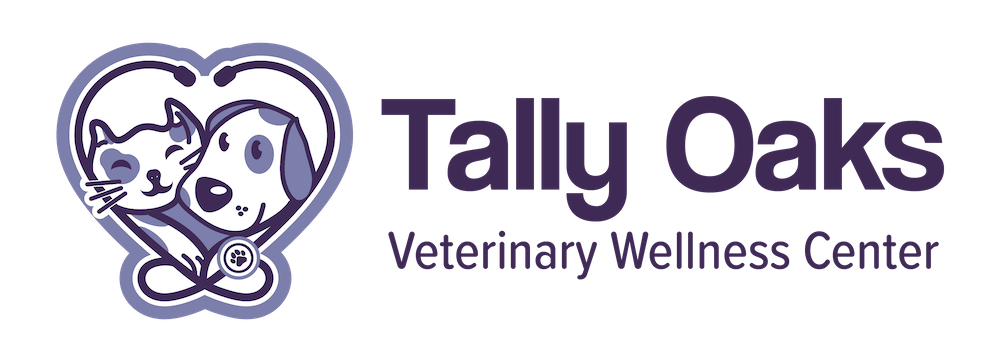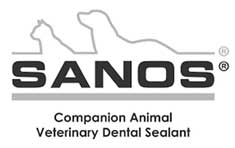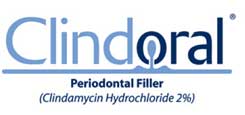Why is your pet’s dental care important?
Dental issues and diseases are highly common among dogs and cats. In fact, about 80 percent of dogs and more than half of all cats over the age of three experience some form of dental disease. If left untreated, bacterial plaque and calculus stay under the gum line and result in gingivitis (inflamed, red gums) and over time result in infection and gum recession along with bone loss.
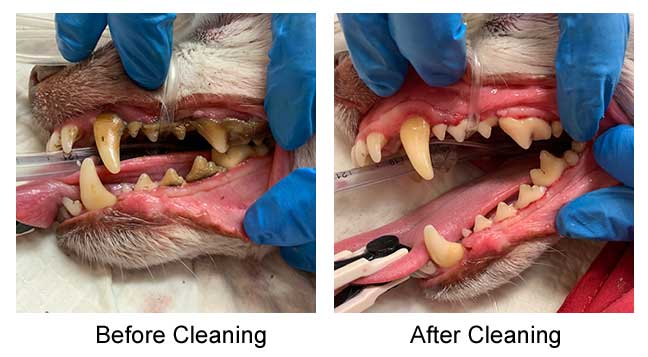
When gingival recession and bone loss is severe enough, eventually diseased teeth will loosen, and can then fall out. Chronic infection is known to have a detrimental impact on the systemic health of your pet and can lead to heart, kidney, and liver disease and many other life-threatening conditions.
What can you do to prevent dental disease in your pet?
Some of the above issues may sound scary, but not to worry! Through proper oral care, you can keep your pet’s teeth in top shape.
1. Brush Your Pet’s Teeth Daily
Just like humans, regular tooth brushing is the easiest way to keep your pet’s teeth healthy. A number of different toothbrushes can be used. However, you should never use human toothpaste. Instead use a toothpaste formulated for pets.
It can be difficult to get your pet comfortable with their first tooth brushing session. Here are some tips to ease them into it:
1. Use your fingers to touch your pet’s lips, then teeth and gums, to accustom them to something contacting these areas and their mouth being handled.
2. Put a small amount of toothpaste on your pet’s lips to introduce them to the taste.
3. Let your pet sniff the toothbrush, and then gently move the brush around their mouth.
Once your pet is willing to let you brush their teeth, apply the toothbrush at a 45-degree angle using a gentle circular motion. Concentrate on one area at a time, and pay attention to the sides that touch the cheeks. Most pet toothpaste can be swallowed, so don’t worry about rinsing your pet’s mouth after brushing!
Here are some helpful videos to guide you through the process of brushing your pet’s teeth:
Dogs:
https://www.youtube.com/watch?v=54WroRd1GiA
Cats:
https://www.youtube.com/watch?v=4KPmWOQydfY
https://www.youtube.com/watch?v=3dBySVcgIYI
You should repeat this process every day or two to prevent plaque and tartar growth.
2. Provide Dental Chews/Toys for Dogs as a supplement to brushing
Using dental chews are a great way to supplement your dog’s regular dental routine. Historically in nature, dogs maintained their oral health through chewing things like sticks and animal bones. This behavior helped to scrape off plaque and tartar, naturally keeping their teeth healthy.
Dog dental chews aim to do the same; scrape off and slow the formation of plaque and tartar, while also strengthening teeth. As dogs have a natural desire to chew and play, adding dental chews is a great way to maintain oral health while also keeping them happily occupied! A few suggestions for buying dental chews:
Select the correct size of chew: Large dogs should have chews big enough to not present a choking hazard. Small dogs should have a size that’s not too difficult to bite on.
Look for chews that meet the Veterinary Oral Health Council (VOHC) approval. VOHC maintains a full list of approved dental treats recommended by veterinary experts. In order to receive the VOHC approved seal, a dental chew must reduce plaque or tartar by a minimum of 15% for friction based options. Enzyme or compound based chews must reduce plaque or tartar by 20%.
http://www.vohc.org/
http://www.vohc.org/VOHCAcceptedProductsTable_Dogs.pdf
http://www.vohc.org/VOHCAcceptedProductsTable_Cats.pdf
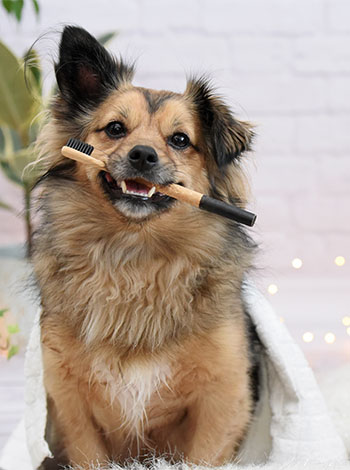 If your dog likes to chew on other objects, avoid extremely hard objects that can splinter such as antlers and wood. The rule of thumb for bones is to only give raw bones, never cooked bones, and avoid flat bones which can splinter. Never feed your dog smoked bones as these can cause intestinal blockage. Chew toys should be indestructible yet soft enough to encourage chewing.
If your dog likes to chew on other objects, avoid extremely hard objects that can splinter such as antlers and wood. The rule of thumb for bones is to only give raw bones, never cooked bones, and avoid flat bones which can splinter. Never feed your dog smoked bones as these can cause intestinal blockage. Chew toys should be indestructible yet soft enough to encourage chewing.
3. Inspect you pet’s mouth frequently
If you see any of these signs, you need to have your pet seen immediately.
- Dirty or discolored/brownish-greenish teeth, (tartar or plaque)
- Broken or loose teeth
- Swelling, redness, or bleeding of the gums
- Foul smelling breath
- Difficulty or abnormal chewing, dropping, or avoiding food
- Unexplained weight loss
- Growths on the tongue or gums
4. Schedule annual dental exams with your veterinarian
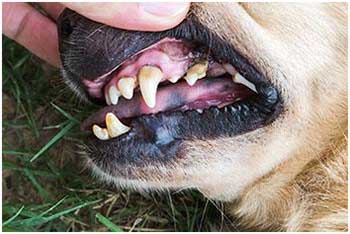 Your veterinarian should conduct an oral exam every time an annual examination is performed. Through careful observation of the teeth and gums, palpation of the gums and surrounding tissues and assessment of the pet’s breath, your veterinarian should be able to give you guidance on the condition of your pet’s dental needs. If your dog is very timid, fractious or painful they may require sedation in order to more closely examine the oral cavity. The examination will determine if your pet needs a dental cleaning or if there is dental disease or abnormalities that need to be addressed.
Your veterinarian should conduct an oral exam every time an annual examination is performed. Through careful observation of the teeth and gums, palpation of the gums and surrounding tissues and assessment of the pet’s breath, your veterinarian should be able to give you guidance on the condition of your pet’s dental needs. If your dog is very timid, fractious or painful they may require sedation in order to more closely examine the oral cavity. The examination will determine if your pet needs a dental cleaning or if there is dental disease or abnormalities that need to be addressed.
Please call us to set up your dental examination so we can evaluate your pet’s dental needs and help you chart a course of action.
What is actually done in a dental cleaning?
Your pet is put under general anesthesia. This is necessary for several reasons. First, a dental cleaning involves water, and to prevent aspiration, an endotracheal tube must be inserted into the trachea so fluids cannot drain into the lungs. Secondly, a thorough cleaning requires subgingival cleaning best done with an ultrasonic scaler. Cleaning under the gums is very uncomfortable and general anesthesia provides a safer level of more profound analgesia which is necessary to do a thorough job. Finally, if your pet requires extractions, general anesthesia is the most humane way to provide pain-free extractions, along with regional nerve blocks.
We start by inspecting the entire oral cavity, including the teeth, gums, tongue, back of mouth, and documenting any abnormalities. Missing teeth or extra teeth are noted as well as any loose or damaged teeth. We then begin removing gross deposits of calculus with dental forceps, after which the ultrasonic scaler is used to remove the subgingival plaque and calculus that are directly responsible for periodontal disease. This will improve the odor of the breath and appearance of the teeth. During the cleaning process, we evaluate the oral cavity for periodontal pockets, enamel defects, exposed tooth roots, and tooth instability. If disease has been present for too long, we may discover that one or more of the teeth needs special attention. Our first and foremost goal is to save the teeth if we can.
After the teeth have been cleaned, they are polished above and below the gum line. In the case of deep periodontal pockets, we may need to inject Clindoral (a long acting antibiotic gel) under the gum line. If the pocket below the gum line or the bone loss and disease is too significant then tooth extraction if often necessary.
If the teeth are in good condition but the animal tends to accumulate plaque and tartar quickly, we will apply a dental sealant called SANOS to prolong the interval between dental cleanings.
Our first and foremost concern is to make sure your pet is pain free during dental procedures by using intraoperative pain medicine and local anesthetic blocks as needed.
What do dog and cat dental cleanings cost?
Each patient must be approached and treated as an individual with unique needs. We employ highly trained, caring, licensed professionals to ensure your dog or cat’s comfort and safety; all while using state of the art anesthetic and dental equipment to ensure high-quality dental and oral surgical care for your pet. The cost of the dental cleaning is based on many factors, including weight of your pet, the extent of periodontal disease present, and the number of extractions that are required. The following estimates are be based on a relatively healthy mouth that requires no “extras.” After we have evaluated your pet, we will give you a more detailed estimate of what to expect, along with a range for the unexpected.
